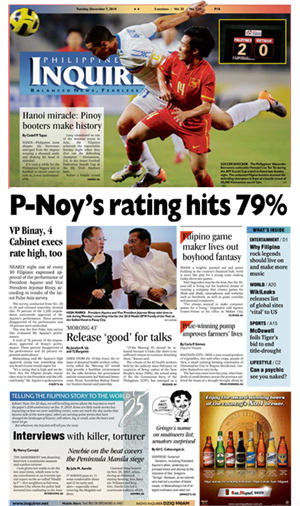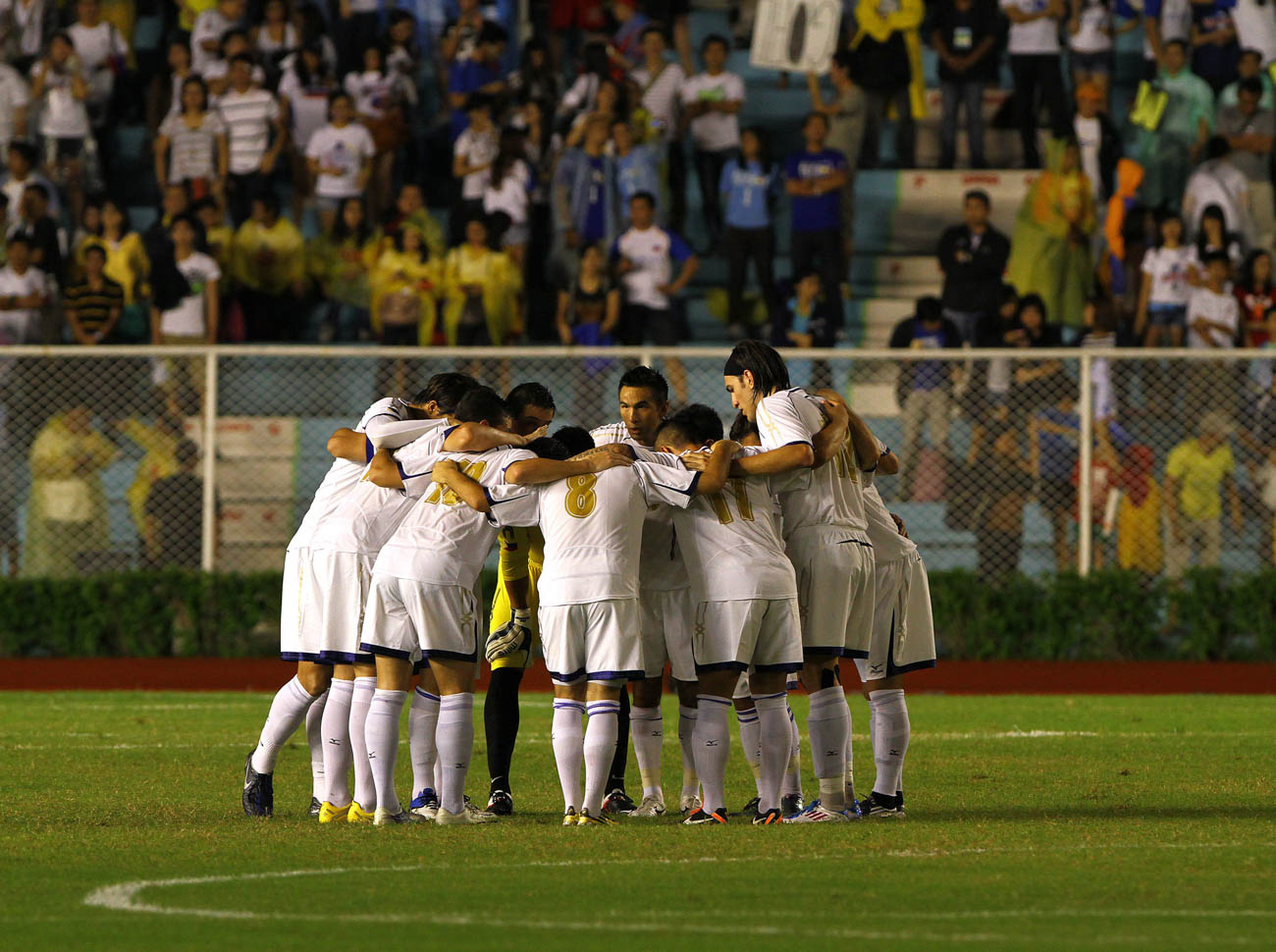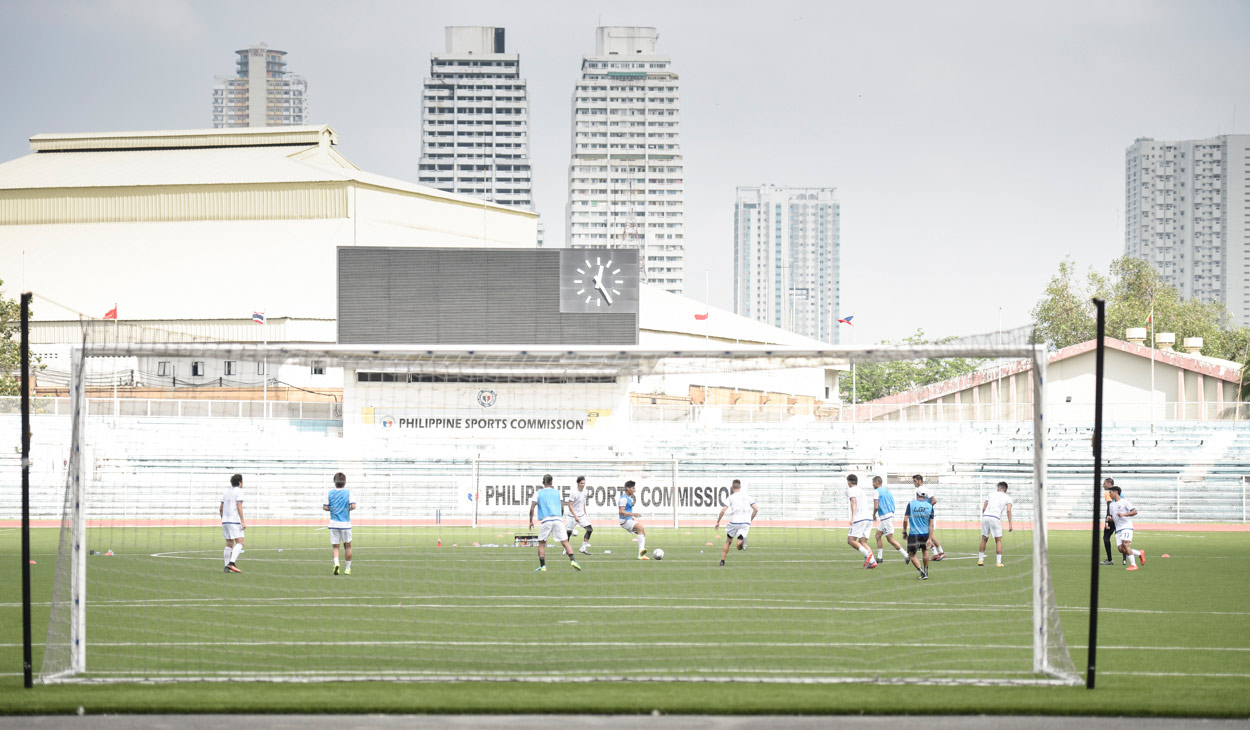Much like the sport itself, the state of football in the Philippines is oftentimes on the brink of a goal, only for the shot to miss and for the play to start all over again.
The successful goals are really only few and far in between. Filipinos fondly remember how in 2010, the historic success of a then lagging national team pushed the sport to mainstream mania.
But close to seven years later, football's growth remains but an unrealized potential, leading many a Filipino to ask: Why has football declined in the Philippines?
The Beautiful Game, as football is fondly dubbed, is a little more difficult to love in a country used to the instant gratification from favorite pastime basketball and emerging fan favorite volleyball.
Dan Palami, team manager of the Philippine Azkals, credits this underappreciation to the lack of education on and exposure of the sport to the uninitiated.
"The excitement in football is not just in the goal scoring," Palami said. "Maybe you score, maybe you don't score, but people who are into football appreciate how a play is developed or how an offensive attack is developed."
"Not too many people are aware of that yet," he added.
What Filipinos are acutely aware of, instead, are the big personalities that comprised the 2010 Azkals-to the boon (and bane) of the sport's popularity in the country. The Younghusbands and Caligdong and more are household names, but ask any Filipino what else they know about football and the answer is most likely none.

"Where football is now, much of it is influenced by how the national team is going to perform in the next years," Palami said.
It's not hard to understand why. The Azkals may have won their first qualifying match against Nepal for the 2019 Asian Cup, but the national team has arguably failed to ride the momentum gained in 2010. This lack of success has in turn led to a decline in mainstream interest.
READ: Azkals drub 10-man Nepal to open Asian Cup qualifiers
No two people understand this better than Phil and James Younghusband, considered the poster boys of Philippine football. The Filipino-British brothers have been playing for the national team for about a decade, and were part of the 2010 roster that won the Azkals their first claim to fame.
Today, however, the most common question they're asked is, "When's the next game?"
"For me and James personally, I think there's still the name recall, you know, when we still get recognized when we go out for being involved in football and being involved in the national team," said Phil Younghusband, to his brother's agreement. "We are recognized for what has transpired in the past couple of years, six or seven years, but definitely for Philippine football there has been a decline."
It was but second nature for Filipinos to root for to the underdogs, to latch on to the story of a group of half-Filipino players who, while raised outside the Philippines, were full in their desire to bring home a win for their mothers' country.
The boys would fail to win the Suzuki Cup in 2010, but Azkals mania followed the players through short sprints of success in 2011 and 2012. But soon, the original members retired and left. Talent began flowing in from abroad and some locally, and no longer were the Azkals considered underdogs.
With no compelling narrative to root for, and no more groundbreaking wins under the team's belt, both the fans' fervor and the media exposure waned.

"We had a lot of high expectations because we know where football can go in the Philippines," said Phil. "I think it wasn't sustained because maybe due to our lack of success since. I think there's many factors, I think maybe due to short-term decisions made rather than long-term after that success in 2010."
What those decisions are, Phil declined to elaborate. Instead, he stressed what Palami had also emphasized: a need to make Filipinos love the sport beyond the Azkals.
"Once we had the interest and the awareness of the national team and Philippine football, I think the step to sustaining that was getting people to love the sport, and I don't think we made Filipinos love the sport," he said.
The story of Philippine football, therefore, cannot solely hinge on a love of the Azkals. To rely on their popularity alone would be, in the words of Palami, "disastrous." For the sport to move forward from its 15 minutes of fame, it has to step out of the shadow of the personalities that sparked interest in the first place.

Chris Greatwich, a former Azkal, knows his claim to fame is the header that kickstarted the national team's historic run in the 2010 Suzuki Cup. But today, he'd rather be remembered for his other passion: coaching kids of all ages in football as director of Kaya FC Academy.
"Essentially what we're trying to do is promote the sport to the kids and whether it's kids who are just looking to improve, kids who are looking to have fun and enjoy it, and kids who aspire to become a professional player or an Azkal themselves," he said. "It's important that we provide the platform for these kids to have fun and enjoy the sport and also to learn and develop, to achieve whatever they want to achieve."
Kaya FC Academy has since trained over 1,000 kids as young as 2 years old since it first opened in 2010. Greatwich came on board in 2013.
The academy also sponsors underprivileged children from a Gawad Kalinga community nearby, who without the support would not have an avenue to play football on a larger scale.
And Kaya FC Academy is not alone. The Younghusbands, who play for Meralco Sparks FC outside of their stint with the national team, also have their own football academy active in the summer. Private companies have also sponsored their own camps and workshops, with some even sending children abroad to train with the European ligas.
"I think that's a testament to post-2010, the people who have come over here and the work that they've done," said Greatwich. "They've really tried to develop grassroots football. And I definitely think the standards of football have definitely improved amongst the younger age groups."
"Ultimately, you need to bring the game to the masses, and you have to go to the provinces and bring it to the rest of the country," he added.
Once that happens, today's kids will experience what once seemed impossible for the sport: professional football as a viable career, just like in basketball and volleyball.
"There are a lot more kids now who see that there is a viable pathway into professional football," said Greatwich. "They see that professional football is a viable career option for them and that's why a lot of these kids are more invested in trying to develop themselves as best as they can."
"It's up to the young guys, the younger generation coming through to pick up the torch and run with it," he added.
The pressure to promote football as a career on the grassroots level is even more palpable outside Metro Manila, where provinces like Cebu and Iloilo are known hotbeds of the sport. In Bacolod City, games at Panaad Stadium are attracting diehard and casual fans alike, all of whom see football as a passion and as entertainment.
"We have a lot of grassroots players in the country. Every festival we have, there are always a lot of kids. So it's encouraging to see kids that are playing not only in Metro Manila but all over the country," said Philippine Football Federation (PFF) president Mariano "Nonong" Araneta.
In 2014, the PFF was recognized for its grassroots initiative at the Asian Football Confederation Annual Awards. Araneta, who has served as PFF president since 2010, said improving its grassroots programs remained the organization's main focus.
READ: AFC award for PFF's 'Kasibulan' program
"That's really the role of the PFF: to promote football, to develop football," he said. "I think we really have to develop from the grassroots and just graduate it to the youth, so that later on we have more players playing for the national team or the club teams."
"While they don't have clubs or they're not professionals, it's the duty of the PFF to create the necessary tournaments for them, the training for them," he added.
Among the tournaments organized by the PFF are the Regional Festival of Football and the PFA-Youth Championship. This year, Fifa and the Asian Football Confederation have provided more than quadrupled the PFF's current budget. Araneta said the money would be used to conduct more football festivals and tournaments in more provinces across the country in the coming years.
And it's not just private entities involved in current grassroots programs. The Philippine Marine Corps, for instance, has a program called Football for Peace, where members of the military teach and play football with children who live in war-torn provinces.
Among the private entities they have tapped was Loyola-Meralco FC, who played a UFL match against Green Archers United in Zamboanga City. The clubs' players also conducted workshops for about 200 kids.
READ: 'Football for Peace' brings hope to conflict-hit Zambo
Belay Fernando, assistant general manager of Loyola-Meralco FC, said initiatives of the government and military to bring football to the kids
"If you look at it from the grassroots, in the base of it, we're actually experiencing quite a boom from 2010," she said. "You can see so many academies sprouting and so many good players being grown locally."
Fernando, herself a "Maldita" or a member of the national women's football team, cited the 2015 and 2016 silver medals garnered the national football team for girls under 14 years old.
For that to be sustained, however, Fernando said the government must get more involved in promoting the sport, whether it involves building more fields or training physical education teachers how to teach football.
"What's important more is getting the support of a local government unit (LGUs) that fully supports the program," she said. "Then you can really monitor it more and budget from the ground instead of placing people there or sending funds from the stores of PFF."
"Slowly, the LGUs are getting on board and they're realizing that there is a future for our local talent in the sport," she added, citing Laguna province and San Carlos and Taguig cities for their interest in developing the sport in their area.
The PFF, while focused on the grassroots program, also has another immediate task that is crucial to the sports' future: setting up the nationwide Philippines Football League (PFL).
The PFL, set to begin in April this year, is expected to replace the Manila-based United Football League as the top-tier tournament for clubs in the country. Existing clubs will call provinces across the country as home bases; for example, Ceres FC will now be Ceres-Negros FC and will be based in Bacolod City.
READ: Bacolod, the epicenter of football
Like how it is in other football-centric countries, members of the Azkals are also members of football clubs in the Philippines. The Younghusbands play for Meralco Sparks Taguig FC and Greatwich, for Kaya Makati FC. Players who will participate in the PFL are expected to play around 27 games for the tournament's first run.
"As a sport, what PFF has done is to allow the different communities outside Metro Manila to actually participate in a national tournament so the community will know that there is actually football in their region," said Palami, who owns Global Cebu FC.
"Before, it was just a 'Metro Manila affair' because the biggest tournament was being done here. Now that it's going to be done nationwide on a professional level, the sport will only become bigger and will have participation from communities outside Metro Manila," he said.
"That's the only way to make it sustainable, if the games are broadcasting actively," he added.
READ: PFL as football's next kick
At present, the Azkals' tournaments and select UFL games are broadcast only on cable, which a lot of the population may have access to--but their games are often lost in the rich, varied sporting menu of cable TV. The PFF has begun broadcasting the Azkals' matches live on the Internet, but TV is admittedly still the way to go for maximum exposure.
"Obviously you look at the way basketball's set up, there's a lot of interest there. It's shown on TV, it's competitive, it's thrilling to watch. And maybe that's what's needed for football, just that showcase as well," said James Younghusband, whose own interest in football stemmed from watching games in England.
"When you watch it on TV, it inspires you to go out and do that. You wanna just try what you've seen on TV. In the future, if we have more football on TV, then it can get more kids on the streets playing," he added.
Click here for more photos of the Azkals' victory vs Nepal at the 2019 Asian Cup qualifiers. Photos by Tristan Tamayo/Inquirer.net.
Palami, the Younghusbands, Greatwich and Araneta; they and more are the current ambassadors of football, slowly laying down the groundwork for future generations. There are grassroots programs in place to provide a fresh pool for the lagging national team; there will be more leagues for professionals and the youth alike to practice, hone their skills to match up to rivals overseas.
"For football to grow, you need all that working together," said Phil. "It is detrimental to just focus on one, if you're just relying on the success of one team to promote Philippine football. That's dangerous because if you don't get success, then the sport suffers."
"Where we go from now, that's up to everyone involved in Philippine football to think about and try and grow step by step again," he added.
Whether the hard work of everyone involved pays off, however, is yet to be seen.
But much like the sport itself, perhaps the beauty of football's journey to success in the Philippines may be in setting the scene, positioning key players and waiting for the exact chance to strike the next goal.
How long till the next goal? The next score can come as soon as 2019, should the Philippines qualify this year for the Asian Cup.
Palami, however, has a more ambitious dream for football in the country.
"In about five years time, we could actually be sending players out of the country and earn their keep," he said.
Told that it was unheard of, Palami could only laugh.
"Well, the Azkals were unheard of how many years ago. Who knows?"
Who knows indeed.